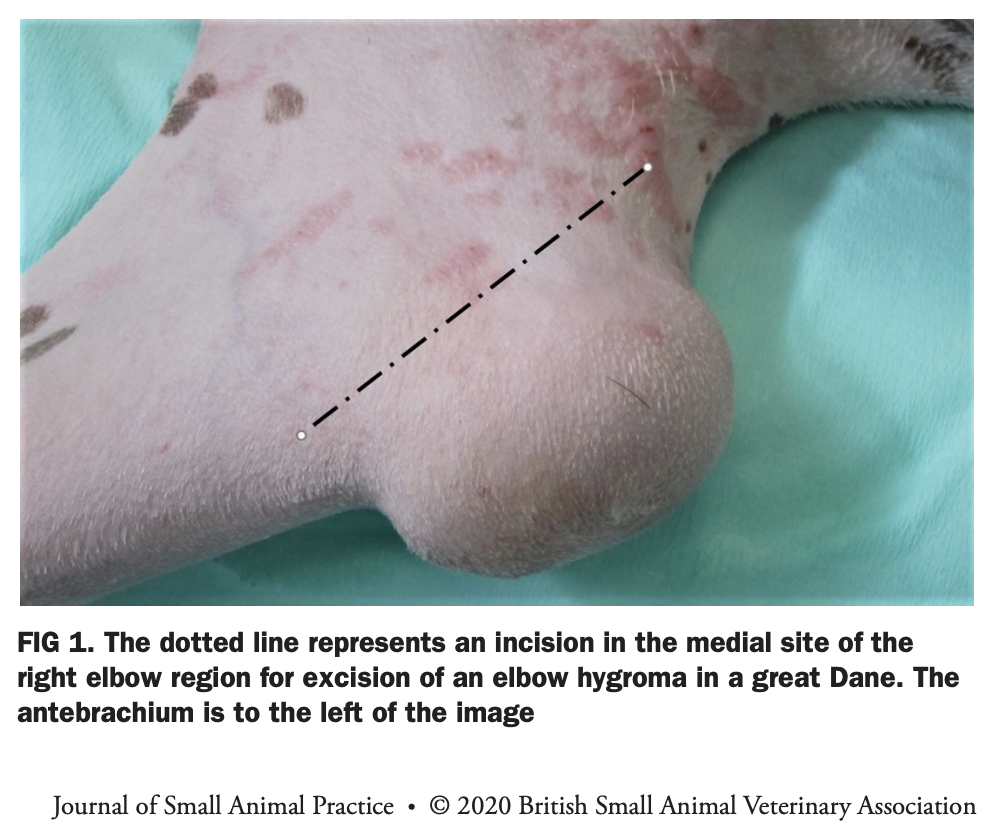Laurie's Blogs.
Aug 2025
Elbow Hygromas

Sometimes I draw a blank when trying to come up with a blog topic. This one started out wondering about the incidence of trochanteric bursitis in dogs (I couldn’t find articles), but then when I typed in “canine bursa” into PubMed, I got a handful of articles about elbow hygromas. So, I went down that rabbit hole instead! Join me as I relay what I learned!
What is an Elbow Hygroma?
Elbow hygroma is a transudate fluid accumulation that forms within the subcutaneous tissues between the skin and the olecranon following repetitive trauma to this bony prominence.
Giant- or large-breed dogs that lie on hard surfaces appear to be most susceptible. Pressure compressing the skin over the olecranon when the dog lies on a hard surface results in blood flow impairment, leading to transudate formation and accumulation in a capsule lined by granulation tissue.
Management Options
Conservative medical management of hygromas includes the use of thick, soft bedding to reduce pressure on the olecranon region. The soft bedding may help reduce progression of hygromas, but their complete resolution varies with the individual case.
Surgical Management has been explored. Due to serious complications of infection and skin ulcerations, a 1975 study concluded, “It is recommended that hygromas should not be treated by aspiration and injection of corticosteroid preparations, or by excision.” This study recommended a simple drainage procedure, and other studies have reported the successful use of Penrose drainage in a single case study.
A 2020 retrospective study consisting of 19 dogs that had either an excision of the hygroma or the Penrose drainage. The results of the study were, “Twenty-one hygromas were treated in 19 dogs. Eleven were right-sided, six were left-sided and four were bilateral. First-line treatment was Penrose drain placement in 12 and complete surgical excision in nine. Bilateral hygromas were addressed simultaneously. Four of the 12 hygromas managed with Penrose drain recurred and one developed ulceration over the olecranon. Recurrent hygromas were treated by surgical excision. The ulceration was surgically excised and reconstructed with a thoracodorsal axial pattern flap. No further complications developed. All the dogs were clinically healthy after a median follow-up of 16months.”
And quite by surprise, I found a 2023 study that used shockwave to treat elbow hygroma. It’s in a German journal however, so I can only provide information based on the abstract. Here’s what I can tell you, “In this case series of 4 consecutive cases in 3 dogs we treated hygromas with extracorporeal shockwaves each for 3 to 6 times usually on a weekly basis. All hygromas regressed completely and no complications were noted. Overall ESWT seems to provide a safe, easy-to-use, as well as cost-effective alternative treatment option for canine elbow hygroma.”
And that, my friends, is your mini lesson on elbow hygromas. I honestly didn’t expect to find the last article, which increases the relevance of this topic to the canine rehab field!
Onward and upward! Until next time…
Cheers! Laurie
References:
Johnston, D. E. (1975) Hygroma of the elbow in dogs. Journal of the American Veterinary Medical Association 167, 213-219.
Kousi, T., Angelou, V., Psalla, D., et al. (2017) Elbow hygroma in the dog. Which treatment works better? Hellenic Journal of Companion Animal Medicine 6, 18-28.
Pavletic, M. M. & Brum, D. E. (2015) Successful closed suction drain management of a canine elbow hygroma. Journal of Small Animal Practice 56, 476-479.
Verhoeven A, Huels N, Harms O. Novel approach for the treatment of canine elbow hygroma with extracorporeal shockwaves. Tierarztl Prax Ausg K Kleintiere Heimtiere. 2023 Jun;51(3):182-188. English.


